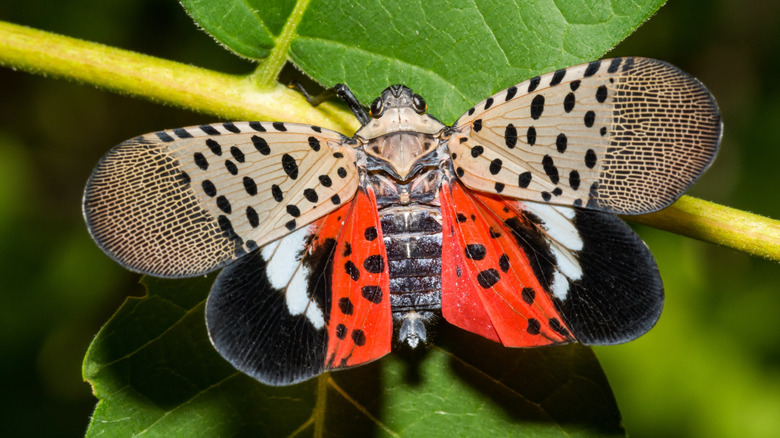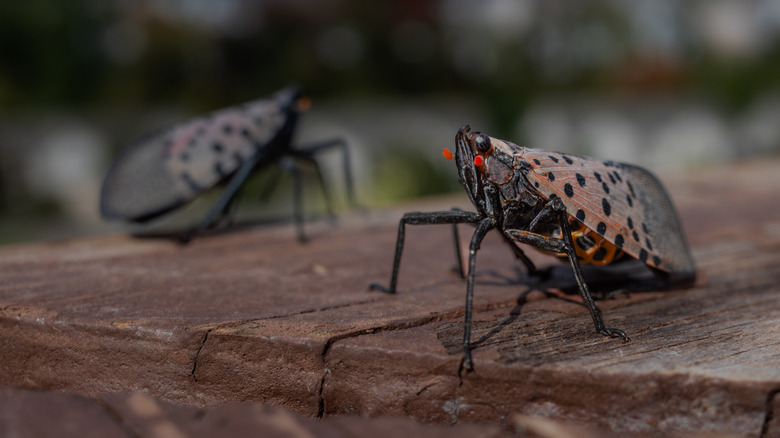The Invasive US Insect With An 'Appetite For Destruction' You Should Never Ignore
Over 6,500 invasive species threaten flora and fauna on the land and sea in the United States alone. Understandably, these staggering numbers do not register with many or are overlooked. Cats are one of the most invasive species, but are given a pass due to their companionship. Worries over the encroaching populations of lionfish that appear in the oceans off the U.S. coast are unlikely to concern someone in a landlocked state. People cannot take on every environmental cause, but a particular invasive species needs everyone's attention and efforts to help prevent its spread: the spotted lanternfly.
First appearing in Pennsylvania in 2014, the spotted lanternfly has since spread to 15 states. Endemic to Vietnam, China, and Hong Kong, this invasive insect was likely introduced accidentally through the importation of goods. The rapid spread of the spotted lanternfly has become a significant concern for conservationists, as it has expanded its range to multiple states in just seven years.
This is unlike other moths, such as the spongy moth. While it has been found in 21 states, the spongy moth has been slowly spreading across America since its introduction in the mid-19th century. The faster spread of the spotted lanternfly is made all the more alarming due to the severe economic losses and ecological strain caused by the non-native bug and its destructive appetite.
Damage done by the lanternfly is in the millions of dollars
While the spotted lanternfly is rarely the direct cause of tree death, it remains a significant pest. Feeding on tree sap with its piercing mouthparts, this large bug damages the tree; however, the additional pests attracted by its excretion, partially digested sap known as honeydew, often prove fatal to the plant. Honeydew also contributes to the development of sooty mold. Although this mold does not necessarily directly harm plants, its unsightly appearance can impede the plant's ability to photosynthesize, and has caused massive damage to many industries.
A 2025 study published in the Journal of Integrated Pest Management showed that the spotted lanternfly has caused significant harm to several key plants, including grapes and maple trees. Focusing solely on its impact on grapes and its effects on the market, the study showed that the state of New York estimated a loss of $1.5 million in the first year of the lanternfly's appearance, followed by increases of $4.0 million and $8.8 million in the subsequent two years from the non-native insect.
The wine industry is just one of many affected, but these pests are now found in other states and Canadian provinces, reflecting a potential for exponential increases in costs and damage as it spreads to new regions. Thankfully, there are ways for people to help stop the spread of the spotted lanternfly.
How to identify the spotted lanternfly and stop its spread
Identifying the spotted lanternfly depends on its life cycle. From October to June, in its instar (developing) stage, it appears as a small black bug that feeds on the sap of herbaceous plants and new growth on trees or shrubs. Depending on the local climate, from July to December, a nymph grows into an adult and develops its recognizable red pattern. An adult will begin to feed from the trunks and branches of trees. Measuring up to an inch in length, the insect is easily identifiable at full development with its size and unique markings.
While the spotted lanternfly casts an intimidating figure, its mouth, designed for sucking sap, renders it incapable of biting people, and it doesn't have stingers. It's also not a bug that poses a threat to outdoor pets. It may not be enjoyable to approach large bugs, but it is essential to note where and how many lanternflies appear to strategize how to handle them. A few may not be cause for concern, but clusters can be. Extermination can range from removing the few that appear to using pesticides and calling for help from an exterminator.
Most states have online reporting tools to assist with extermination. For example, New York state residents can report findings via e-mail to the agricultural department, while Pennsylvania has a dedicated phone line. If you find a spotted lanternfly population close to or on your property, you should take steps to report and eliminate it; its destructive appetite makes it one of the most alarming invasive species in the United States. For more stories on growing wildlife concerns, see the dangerous predator problem in Houston, Texas, that keeps growing.


